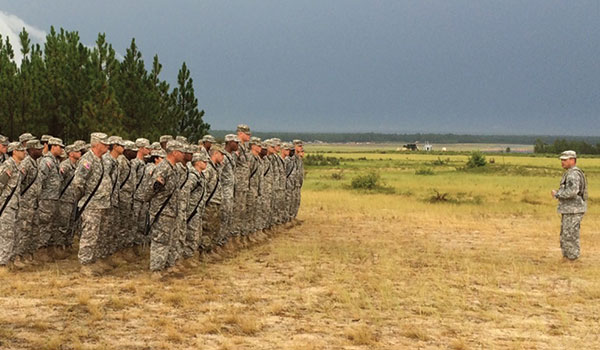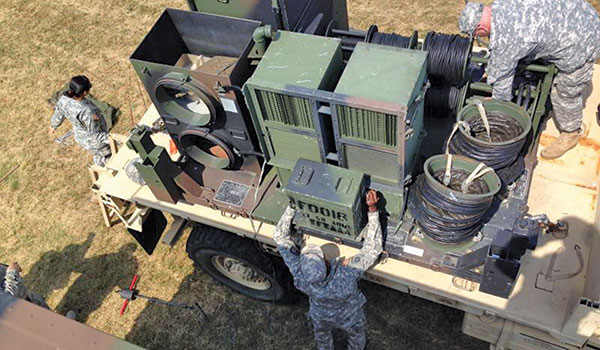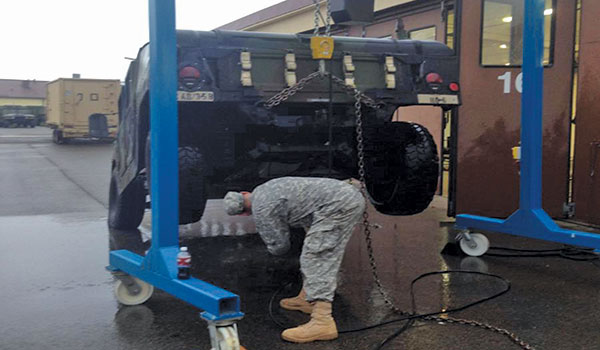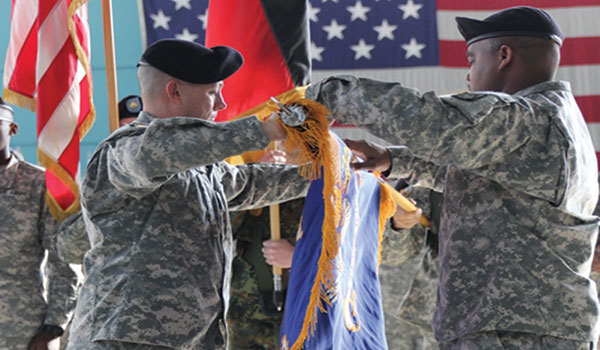
Air Traffic Services / By MAJ Archie L. Smith: With U.S. Army Europe’s (USAREUR) ongoing force structure transformation and the onset of Aviation Restructure Initiative (ARI), one would think executing a unit relocation from Europe back to the U.S. would be a simple operation. This operation would be all the easier, considering the unit has an authorized Modified Table of Organization & Equipment (MTOE) strength of only 71 personnel. However when the 3rd Battalion, 58th Aviation Regiment (an airfield operations battalion) received orders to execute a unit relocation from Illesheim, Germany to Fort Bragg, North Carolina, it was anything but easy.

Soldiers of the 3-58th AOB stand formation with battalion commander, LTC Thomas Lewis, prior to an FOD walk during a Contingency Airfield Management Training Exercise at Camp Mackall, Southern Pines, NC, as part of their relocation validation.
Surpassed by only divorce and death of a relative, most experts say that moving is the third highest cause of stress for Soldiers and families. With the entire unit undergoing a PCS move, the high levels of stress added to the complexity of the operation. Although the execution of this mission proved to be extremely successful, the normal problems and challenges associated with a unit move were compounded due to existing mission requirements, operational tempo of the unit and its higher commands, and the inexperience of its staff. This article provides insight from the 3-58th AOB’s perspective of how effective employment of mission command enabled the unit’s success.
The Mission
3-58th AOB’s mission was to re-locate all personnel and equipment from Storck Barracks, Germany to Ft. Bragg, occupy newly assigned facilities, integrate personnel into the Ft. Bragg community, and establish the key systems in order to begin collective training no later than 15 June 2015.

3-58th AOB Soldiers prepare the AN/T SW-7A Tactical Air Traffic Control Tower for pre-inspection prior to relocation to Ft. Bragg, NC. Pictured are (l to r): SPC Javier Stelle, SSG Montrez Richmond, and SPC Karen Hernandez.
The unit had to accomplish several key tasks to be successful. First it had to ensure the Soldiers, families, and equipment were prepared to relocate to Ft. Bragg. This included meeting all administrative, logistical, and accountability requirements as well as setting the conditions for success at Ft. Bragg. 3-58th AOB also needed to recondition and transfer its current operational footprint to the incoming unit or back to the Directorate of Public Works (DPW). This proved problematic because several pieces of legacy equipment and furniture had non-standard disposition requirements. Most importantly, the unit needed to fully employ the philosophy and leverage the warfighting functions of mission command.
To be successful, they needed to rely on their limited expertise in personnel, equipment, and logistics to translate requirements into detailed and executable movement plans in order to reach the desired end state
Identifying the Problems
The 3-58th AOB’s problem – how could they relocate an airfield operations battalion comprised of over 200 Soldiers and family members from Germany to Ft. Bragg to realign itself to meet FORSCOM’s strategic objective to provide expeditionary air traffic services by 3rd quarter, FY16? And to complicate matters, how could they do it with a junior staff? Several factors were considered critical during the planning phase:
- Maintain unit ATS operations until relieved
- Key leader movement plan will be critical to effective mission command
- Personnel movement constrained by equipment movement timeline and Department of Defense Dependent Schools (DoDDS) requirements
- Enable synchronization of efforts by maintaining transparency with higher commands

SSG Shane Hunter pressure washes a High Mobility Multi-purpose Wheeled Vehicle (HMMWV) in preparation for relocation./3-58TH AOB COURTESY PHOTOS
The MTOE of an airfield operations battalion creates operational challenges not normally found in battalion-size elements. Although a battalion element, an airfield operations battalion is not authorized the typical primary staff personnel found in most battalions. Second, no personnel are slotted (by MTOE) to perform analytical staff specific functions. Third, the majority of the organization’s personnel lacked the experience required for decentralized planning and execution. In addition to not having an officer counterpart, most of the primary staff were working at levels normally designated one or two levels above their current pay grade.
For 3-58th AOB identifying the potential problems and set-backs for the operation was a challenge. Many would argue this type of operation would be a difficult mission to plan and execute for a staff comprised of field grade officers. In retrospect, the problems and challenges associated with this operation can be grouped into three distinctive categories: planning and executing a complex operation; maintaining Soldier and family resilience; and employing mission command for split-based operations.
Critical Planning Factors
One could argue no other operation is more dependent upon situational, informal, and collective leadership than split-based operations. Emplacing the right leaders at the right time and place to set the conditions for effective employment of mission command was no easy task considering the average non-availability time during the permanent change of station (PCS) transition was greater than 21 days. Having few senior noncommissioned officers and even fewer officers, the commander had to not only contend with split-based operations but ensure key leaders were in place to achieve desired results along the unit’s lines of effort (LOE).
Developing Leaders
Although not reflected by MTOE, the 3-58th AVN REGT primary staff is made up of one Major (O-4) as an Executive Officer (XO), one Captain (O-3) as the Operations Officer (duties in addition to their MTOE designated duty positions), Sergeants (E5) as the S1, S4, and S6 NCOICs. With the exception of a Safety Officer and S3 NCOIC (non-MTOE position), all remaining staff personnel are cross-trained and assigned functions as additional duties.
The organization does not have company commanders. Warrant officers are slotted by the MTOE to serve as platoon leaders whom are paired with an ATS platoon sergeant. Likewise with other specialty MOSs that are highly technical, leaders within the ATS community develop their leadership abilities at a slower rate. Finally, the promotion rates for these MOSs are usually faster than other MOSs that develop leaders earlier in their career. As a result, normal tasks and expectations within the factors of leadership are nonstandard, creating significant leadership challenges.
Shortfalls associated with inexperienced leaders and staff thrust into demanding key leadership and staff positions had to be considered as key factors to have the right level of leadership in place for mission accomplishment. Implementing a development strategy that facilitated leader development as an LOE would require the acceptance of the prudent risk required to operate while improving.
Operating While Improving
Challenged by shortfalls with leaders and staff, LOE had to meet the operational end state by establishing an initial operational capacity (IOC) at Ft. Bragg. The unit’s concept of operation was to establish LOE that would create synergies throughout the relocation. Therefore, the unit empowered the ADVON with sufficient authority to establish an IOC. Through shared understanding and a clear commander’s intent, the ADVON met its requirements by prioritizing efforts within each LOE:
- LOE 1: Unit Training Management battalion trains/postures for high state of readiness throughout operation.
- LOE 2: Leader Development – focus in all LOE and Training Domains
- LOE 3: Capacity Building – meeting IOC and full operational capability (FOC) dates
- LOE 4: Integration – ATC facility integration, installation accounts, Ft. Bragg rules of engagement (ROE)
Employing Mission Command
Through coaching and mentorship, the commander ensured the staff understood how he wanted to create operational synergies, where he would accept prudent risks and to what levels.With only two field grade officers in the unit, the XO was placed on the advanced echelon (ADVON). Normally the commander and XO would have an established level of mutual trust; unfortunately the XO had been in the unit less than 30 days prior to being pushed forward as the Forward Commander. Having provided clear intent to the XO, the commander established bi-weekly synch meetings to further open the lines of communication. Ultimately, he built a cohesive command team relationship while still physically located in Germany and simultaneously accomplished tasks for LOE 1 and LOE 2.

LTC Thomas E. Lewis (left), commander of 3rd Bn. (Airfield Operations), 58th Avn. Regt., and unit senior NCO, MSG Walter Kirkland, case the unit colors in Illesheim, Germany on 6 Feb 2015.
Creating a shared understanding as a principle of Mission Command seems simple. It was not. When considering the factors of leadership (lead and communicate), the difference in understanding and situational understanding between senior leaders and junior NCOs can be measured by the difference in the range of implied tasks. To overcome this difference, reiteration of the commander’s intent, consistent staff synchs, and commander’s update briefs were employed, accomplishing several tasks along all LOE.
Implementation of a weekly fragmentary order (FRAGO) system allowed the unit to establish priorities, and shape conditions to achieve mission objectives. A by-product of focused leader development was disciplined initiative. As disciplined initiative increased so did the level of prudent risk the commander accepted. Currently, platoon leaders are expected to plan and execute collective training events for all assigned mission essential tasks (METs) within the Ft. Bragg training area to include coordination with Air Traffic Services Command (ATSCOM) and any applicable ATS organization or asset.
Conclusion
Executing a unit relocation is a complex operation that is stressful for Soldiers and their families. When 3-58th AOB was directed to relocate from Germany to North Carolina, it proved that effective employment of mission command and engaged leadership can create conditions for operational success regardless of the size of the unit or the experience of its personnel. Through the application of Army Doctrine and supporting tactics, techniques, and procedures, 3-58th AOB effectively employed Mission Command to achieve mission success.
MAJ Archie L. Smith was the executive officer of 3rd Bn., 58th Avn. Regt., located at Fort Bragg, NC.








